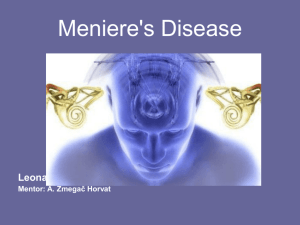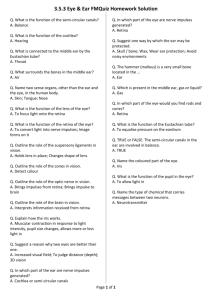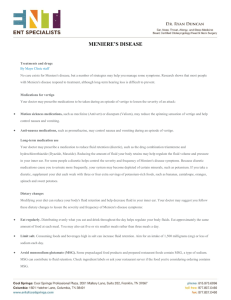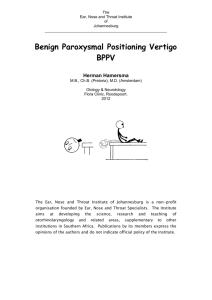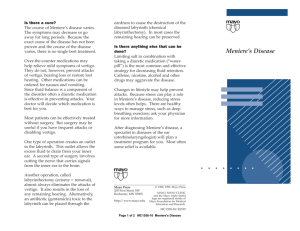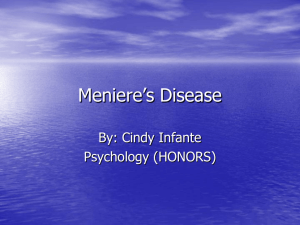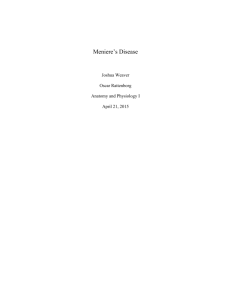Vestibular Disorders
advertisement
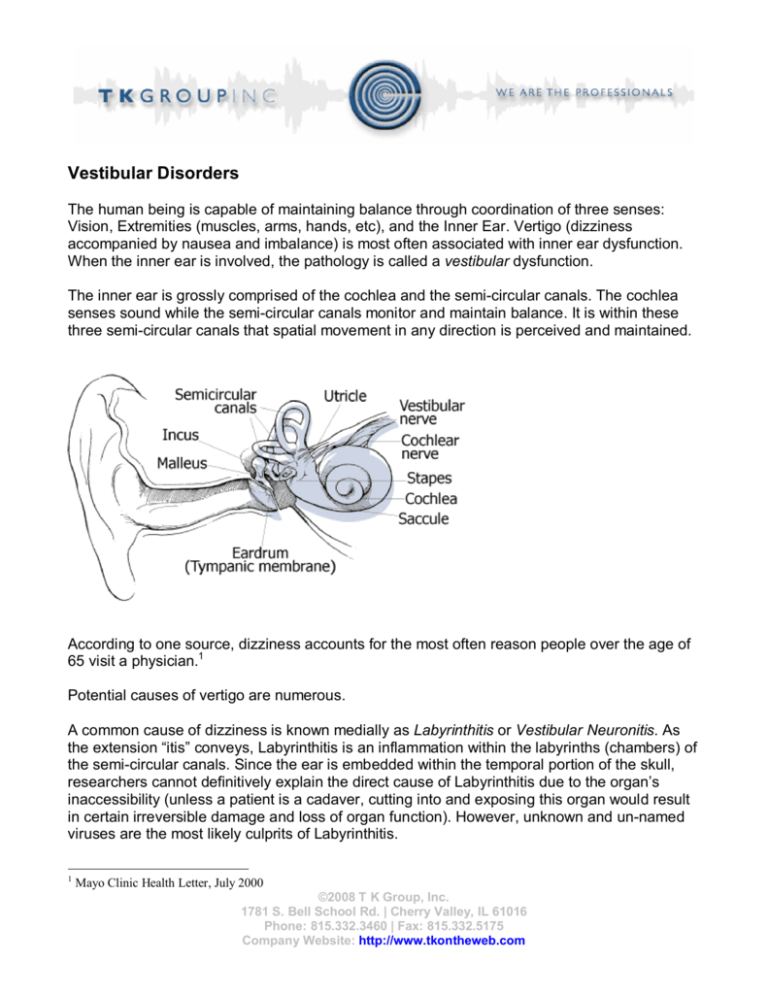
Vestibular Disorders The human being is capable of maintaining balance through coordination of three senses: Vision, Extremities (muscles, arms, hands, etc), and the Inner Ear. Vertigo (dizziness accompanied by nausea and imbalance) is most often associated with inner ear dysfunction. When the inner ear is involved, the pathology is called a vestibular dysfunction. The inner ear is grossly comprised of the cochlea and the semi-circular canals. The cochlea senses sound while the semi-circular canals monitor and maintain balance. It is within these three semi-circular canals that spatial movement in any direction is perceived and maintained. According to one source, dizziness accounts for the most often reason people over the age of 65 visit a physician.1 Potential causes of vertigo are numerous. A common cause of dizziness is known medially as Labyrinthitis or Vestibular Neuronitis. As the extension itis conveys, Labyrinthitis is an inflammation within the labyrinths (chambers) of the semi-circular canals. Since the ear is embedded within the temporal portion of the skull, researchers cannot definitively explain the direct cause of Labyrinthitis due to the organ s inaccessibility (unless a patient is a cadaver, cutting into and exposing this organ would result in certain irreversible damage and loss of organ function). However, unknown and un-named viruses are the most likely culprits of Labyrinthitis. 1 Mayo Clinic Health Letter, July 2000 ©2008 T K Group, Inc. 1781 S. Bell School Rd. | Cherry Valley, IL 61016 Phone: 815.332.3460 | Fax: 815.332.5175 Company Website: http://www.tkontheweb.com Another common cause of vertigo is Meniere s disease. Meniere s disease may attack at any age, although onset is most commonly seen between the ages of 20-50. Meniere s disease is an inner ear disorder characterized by sudden onsets of vertigo accompanied by feeling of fullness in one ear, Tinnitus (ringing in one ear), and fluctuating hearing loss. While both ears may be affected in some cases, classic Meniere s disease most often affects one ear. The root cause of Meniere s disease is to date unknown. There are, however, numerous working theories. The most prevailing theory is that excess endolympth (a fluid contained within the semi-circular canals) collects and builds to the point of exerting abnormal pressure against the walls and nerves located within the labyrinths of the semi-circular canals. This diagnosis is medically referred to as Idiopathic Endolymphatic Hydrops 2. This theorized condition is not unlike the workings of the disease called Glaucoma which affects the human eye. Treatment for Meniere s disease is limited in scope and effectiveness. Diet restrictions are an initial course of remediation. It is well documented that certain foods (salt, alcohol, and caffeine-the usual suspects) trigger and exacerbate the symptoms of Meniere s disease. The second line of defense is drug treatment. Lastly, surgical options include partial or total nerve severing or extraction which when carried-out, effectively kills the ear. Benign Paroxysmal Positional Vertigo (BPPV for short) is another common medical pathology theorized responsible for vertigo. BPPV generally affects individuals 50 years of age and older.3 The junction where the three semi-circular canals converge is called the Utricle. Tiny particles composed of calcium carbonate4 called Otoconia become dislodged from utricle mostly as result from head trauma, infection, or due to the natural aging process. The dislodged Otoconia essentially become floating debris within the inner ear s semi-circular canals and most often settle in the posterior semi-circular canal. Sudden head movements and/or body positions cause accumulated Otoconia to gravitate and forcefully over-stimulate nerves responsible for detecting balance and orientation. BPPV has been effectively managed through the implementation of a procedure referred to as the Canalith Repositioning Procedure.5 In short, this procedure moves or repositions 2 American Academy Otolaryngology-Head and Neck Surgery-Meniere s Disease, http://www.entnet.org/meniere.html 3 Mayo Clinic Health Letter, July 2000 Timothy C. Hain, MD, Benign Paroxysmal Positional Vertigo, http://www.vestibular.org/bppv.html 5 Mayo Clinic Health Letter, July 2000 ©2008 T K Group, Inc. 1781 S. Bell School Rd. | Cherry Valley, IL 61016 Phone: 815.332.3460 | Fax: 815.332.5175 Company Website: http://www.tkontheweb.com 4 accumulated Otoconia back to the utricle by making the patient perform distinct head and body positions. Additional culprits responsible for Vertigo include impacted Cerumen (earwax), Otitis Media (middle-ear infection), and Ototoxic drugs or substances (please refer to T K Group NewsSummer 2000 for a complete review of Ototoxins). Vertigo may also be signs of more significant medical conditions such as stroke and tumors. Causes of Vertigo are potentially many. If you or someone you know suffers from these symptoms, a physician visit is recommended. _________________________________________________________ Authored by: Robert Williams, Au.D. | Director Audiology | T K Group, Inc. ©2008 T K Group, Inc. 1781 S. Bell School Rd. | Cherry Valley, IL 61016 Phone: 815.332.3460 | Fax: 815.332.5175 Company Website: http://www.tkontheweb.com

